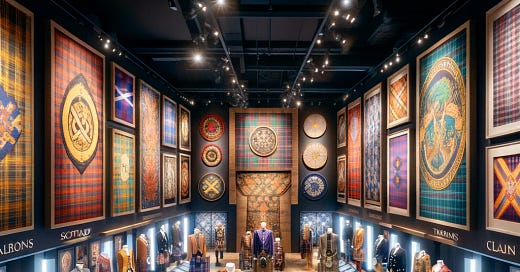Colors of Kinship: Exploring the Meanings Behind Clan Tartans
Scotland's landscape is as diverse and rich as the tapestry of clan tartans that adorn it—a vivid mosaic of colors and patterns, each telling its own story of heritage, valor, and enduring pride. This post delves deeper into the history and significance of Scottish clan tartans, exploring the intricate details and fascinating examples that embody the spirit of Scotland and its clans.
Tartan's journey from the rugged Highlands to a symbol of Scottish identity is a testament to the resilience and creativity of the Scottish people. Initially worn as a versatile garment called the "plaid," tartan's criss-crossed patterns were not merely decorative but served practical purposes, aiding in camouflage and warmth. As clans began to adopt specific tartans, these patterns transformed into a visual language of identity and allegiance.
Clan Tartans: A Kaleidoscope of Stories
Among the sea of tartans, each clan's tartan stands as a unique emblem of its history and values. Take, for example, the MacDonald clan tartan, known for its deep reds and greens, symbolizing the clan's strength and connection to the land. In contrast, the Campbell tartan features darker blues and greens, reflecting their maritime heritage and the misty landscapes of their territories.
Another poignant example is the Stewart tartan, with its royal blue and green accented by yellow and red, a nod to the clan's historic ties to the Scottish monarchy. Meanwhile, the Douglas tartan, with its bold combination of blues and greens, tells a tale of their storied past as warriors and guardians of the Scottish borders.
The Cultural Renaissance of Tartans
Following the repeal of the Dress Act in 1782, tartan experienced a renaissance, becoming a potent symbol of Scottish identity and defiance. This resurgence was further propelled by the romantic visions of Scotland popularized by authors like Sir Walter Scott, who helped organize the visit of King George IV to Scotland in 1822, an event that saw a flamboyant display of tartan and Highland dress, cementing tartan's role in the national consciousness.
In contemporary Scotland, tartans continue to be a vibrant part of cultural and everyday life. Not confined to traditional attire, tartans have found their way into modern fashion, interior design, and even corporate branding, a testament to their timeless appeal and versatility. The annual Tartan Day celebrations, observed not just in Scotland but around the world, underscore the global resonance of Scottish heritage and the universal appeal of tartan as a symbol of solidarity and identity.
The Living Legacy of Tartans
Efforts to preserve and promote tartan heritage are crucial in keeping this vibrant aspect of Scottish culture alive. The Scottish Tartans Authority and the Scottish Register of Tartans serve as guardians of tartan's rich legacy, documenting each pattern's history and symbolism, ensuring that the stories woven into each tartan are not lost to time.
Tartan is more than cloth; it is a narrative woven from the threads of history, culture, and identity. It celebrates the diversity and unity of Scotland's clans, telling tales of battles fought, lands cherished, and communities bonded through centuries. As we wrap ourselves in the warmth of a tartan, we are enveloped in the enduring spirit of Scotland—a nation proud of its past and embracing its future with open arms.





